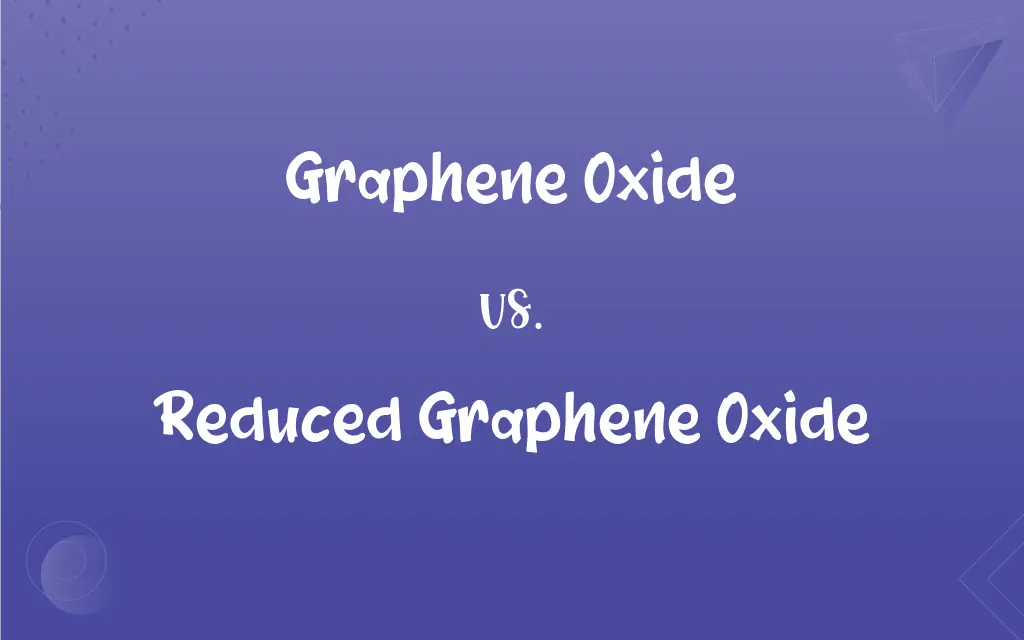Graphene Oxide vs. Reduced Graphene Oxide: What's the Difference?
Edited by Aimie Carlson || By Janet White || Published on January 27, 2024
Graphene oxide is chemically modified graphene with oxygen groups, used for its functional properties; reduced graphene oxide is graphene oxide with reduced oxygen content, enhancing conductivity and mechanical strength.

Key Differences
Graphene Oxide (GO) is an oxidized form of graphene, characterized by the presence of oxygen functional groups like hydroxyl and epoxide on its surface. These groups disrupt graphene's conjugated structure, affecting its electrical properties. Reduced Graphene Oxide (rGO) is obtained by removing some of these oxygen groups, partially restoring graphene's structure and improving its electrical conductivity.
The production of Graphene Oxide involves treating graphite with strong oxidizers, which leads to a material that is easier to process and disperse in solvents. Reduced Graphene Oxide is created by chemical, thermal, or electrochemical reduction methods, which aim to reduce the oxygen content and recover some of graphene's unique properties.
In terms of applications, Graphene Oxide is used in areas like sensors, composites, and energy storage, where its functional groups can be advantageous. Reduced Graphene Oxide, with its improved electrical and mechanical properties, finds use in electronic devices, energy applications, and as a material for environmental remediation.
The structural integrity of Graphene Oxide is compromised compared to pristine graphene, due to the disruption caused by oxygen groups. This results in decreased electrical and thermal conductivity. The reduction process in Reduced Graphene Oxide aims to restore these properties to a degree, but the end product still does not match the conductivity of pure graphene.
The presence of oxygen in Graphene Oxide makes it hydrophilic, improving its dispersibility in water and other solvents. The reduction process in Reduced Graphene Oxide often leads to a less hydrophilic material, which can influence its compatibility with different matrices in composite materials.
ADVERTISEMENT
Comparison Chart
Oxygen Content
High, with various oxygen functional groups
Reduced oxygen content
Electrical Conductivity
Lower due to disrupted structure
Higher, closer to pure graphene
Production Process
Oxidation of graphite
Reduction of graphene oxide
Applications
Sensors, composites, energy storage
Electronic devices, energy applications
Hydrophilicity
High, easily dispersible in solvents
Lower, less hydrophilic
ADVERTISEMENT
Graphene Oxide and Reduced Graphene Oxide Definitions
Graphene Oxide
Characterized by disrupted electrical properties due to oxidation.
Graphene oxide is used in sensor applications due to its modified electrical conductivity.
Reduced Graphene Oxide
Less hydrophilic compared to GO, affecting its dispersibility.
Reduced graphene oxide's decreased hydrophilicity is a consideration in composite material design.
Graphene Oxide
Used for its ease of processing and dispersion in various applications.
Graphene oxide is favored in composite materials for its easy dispersion.
Reduced Graphene Oxide
Does not fully regain the properties of pristine graphene.
While improved, reduced graphene oxide still falls short of the conductivity of pure graphene.
Graphene Oxide
Has reduced mechanical and thermal properties compared to graphene.
Despite its reduced strength, graphene oxide is useful in many polymer composites.
Reduced Graphene Oxide
Partially restored graphene, with reduced oxygen content.
Reduced graphene oxide is used in electronic circuits due to its improved conductivity.
Graphene Oxide
Oxidized form of graphene with various oxygenated groups.
Graphene oxide's hydrophilic nature makes it suitable for water purification filters.
Reduced Graphene Oxide
Obtained through chemical, thermal, or electrochemical reduction of GO.
The reduction of graphene oxide can be achieved through thermal treatment.
Graphene Oxide
Produced by treating graphite with strong oxidizers.
The production of graphene oxide involves chemical oxidation of graphite.
Reduced Graphene Oxide
Features better electrical and mechanical properties than GO.
Reduced graphene oxide is integrated into batteries for enhanced performance.
FAQs
What are the applications of graphene oxide?
GO is used in sensors, composites, and energy storage devices.
Can graphene oxide be dispersed in water?
Yes, its hydrophilic nature allows easy dispersion in water.
What is graphene oxide?
It's an oxidized form of graphene with oxygen-containing groups.
How is reduced graphene oxide different from graphene oxide?
rGO is GO that has been partially reduced to restore some of graphene's properties.
Is reduced graphene oxide as conductive as pure graphene?
No, it's more conductive than GO but not as much as pure graphene.
What methods are used to reduce graphene oxide?
Chemical, thermal, or electrochemical reduction methods.
What makes graphene oxide suitable for sensor applications?
Its modified electrical properties due to oxidation.
Is reduced graphene oxide used in energy applications?
Yes, particularly in batteries and supercapacitors.
Why is reduced graphene oxide more conductive than graphene oxide?
The reduction process decreases oxygen content, restoring electrical conductivity.
How is graphene oxide produced?
By treating graphite with strong oxidizers.
Does the reduction of GO fully restore graphene's properties?
No, it only partially restores properties like conductivity.
Does reduced graphene oxide retain any of GO's hydrophilic properties?
It's less hydrophilic than GO, affecting its use in certain applications.
How does the reduction process impact graphene oxide’s mechanical properties?
It improves them, but they don't fully match pure graphene.
How does the presence of oxygen affect graphene oxide's properties?
It disrupts the electrical and thermal conductivity.
What is the main advantage of graphene oxide in composites?
Its ease of dispersion in various matrices.
Can graphene oxide be used in water purification?
Yes, its hydrophilic nature is beneficial in filtration applications.
What challenges exist in the production of reduced graphene oxide?
Achieving uniform reduction and balancing conductivity with other properties.
Are graphene oxide and reduced graphene oxide hydrophilic?
GO is hydrophilic, while rGO is less so.
Can reduced graphene oxide be used in electronic devices?
Yes, its improved conductivity makes it suitable for electronics.
Is the research on graphene oxide and reduced graphene oxide ongoing?
Yes, research is active in exploring and enhancing their properties and applications.
About Author
Written by
Janet WhiteJanet White has been an esteemed writer and blogger for Difference Wiki. Holding a Master's degree in Science and Medical Journalism from the prestigious Boston University, she has consistently demonstrated her expertise and passion for her field. When she's not immersed in her work, Janet relishes her time exercising, delving into a good book, and cherishing moments with friends and family.
Edited by
Aimie CarlsonAimie Carlson, holding a master's degree in English literature, is a fervent English language enthusiast. She lends her writing talents to Difference Wiki, a prominent website that specializes in comparisons, offering readers insightful analyses that both captivate and inform.







































































